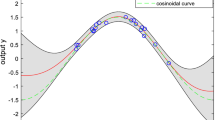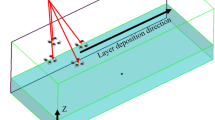Abstract
Among the various direct-write (DW) techniques, aerosol jet printing (AJP) has the advantages of high resolution (~ 10 μm) and flexible working distance (2-5 mm). On this basis, it has emerged as a promising DW technology to precisely customize complex electrical functional devices. However, the micro-electronic devices fabricated using AJP suffer from low electrical performance because of inferior printed line geometric characteristics. Specifically, high edge roughness lines are detrimental to the uniformity of the formed electrical functional devices. In addition, the low controllability of the printed line width may induce overlap of narrowly spaced circuits or unnecessary intertrack voids, which will hinder the wide application of AJP technology in advanced electronic manufacturing industry. Therefore, ensuring high precision of the line width and low edge roughness is of primary importance for AJP technology. In this research, a machine learning framework is proposed for rapid optimization of printed line characteristics. In the proposed framework, SHGFR and CGFR were considered as input variables, and line width and line roughness were taken as the target responses. Three representative machine learning algorithms, tree-based random forest regression, kernel-based support vector machine, and Bayesian-based Gaussian process regression, were then adopted for model development. Subsequently, the identified optimal machine learning model was integrated with a NSGA-III for rapid optimization of printed line characteristics, and experiments validated the effectiveness of the adopted approach.
















Similar content being viewed by others
Data Availability
Data is made available on request.
References
Cummins, G., & Desmulliez, M. P. Y. (2012). Inkjet printing of conductive materials: A review. Circuit World, 38(4), 193–213. https://doi.org/10.1108/03056121211280413
Khan, S., Lorenzelli, L., & Dahiya, R. S. (2015). Technologies for printing sensors and electronics over large flexible substrates: A review. IEEE Sensors Journal, 15(6), 3164–3185. https://doi.org/10.1109/JSEN.2014.2375203
Li, Q., Zhang, J., Li, Q., Li, G., Tian, X., Luo, Z., Qiao, F., Wu, X., & Zhang, J. (2019). Review of printed electrodes for flexible devices. Frontiers in Materials. https://doi.org/10.3389/fmats.2018.00077
Gupta, A. A., Bolduc, A., Cloutier, S. G., Izquierdo, R. (2016). Aerosol jet printing for printed electronics rapid prototy**. In 2016 IEEE International Symposium on Circuits and Systems (ISCAS) (pp. 866–869). https://doi.org/10.1109/ISCAS.2016.7527378
Wilkinson, N. J., Smith, M. A. A., Kay, R. W., & Harris, R. A. (2019). A review of aerosol jet printing—A non-traditional hybrid process for micro-manufacturing. The International Journal of Advanced Manufacturing Technology, 105(11), 4599–4619. https://doi.org/10.1007/s00170-019-03438-2
Park, S.-I., Quan, Y.-J., Kim, S.-H., Kim, H., Kim, S., Chun, D.-M., Lee, C. S., Taya, M., Chu, W.-S., & Ahn, S.-H. (2016). A review on fabrication processes for electrochromic devices. International Journal of Precision Engineering and Manufacturing-Green Technology, 3(4), 397–421. https://doi.org/10.1007/s40684-016-0049-8
Kim, S., Kim, D. H., Kim, W., Cho, Y. T., & Fang, N. X. (2021). Additive manufacturing of functional microarchitected reactors for energy, environmental, and biological applications. International Journal of Precision Engineering and Manufacturing-Green Technology, 8(1), 303–326. https://doi.org/10.1007/s40684-020-00277-5
Song, J.-H., Jung, W.-K., & Ahn, S.-H. (2023). Improved energy efficiency of laser-enhanced nanoparticle deposition system analyzed with a smart power monitoring device. International Journal of Precision Engineering and Manufacturing-Green Technology. https://doi.org/10.1007/s40684-022-00494-0
Tan, H. W., Tran, T., & Chua, C. K. (2016). A review of printed passive electronic components through fully additive manufacturing methods. Virtual and Physical Prototy**, 11(4), 271–288. https://doi.org/10.1080/17452759.2016.1217586
Cantù, E., Tonello, S., Abate, G., Uberti, D., Sardini, E., & Serpelloni, M. (2018). Aerosol jet printed 3D electrochemical sensors for protein detection. Sensors, 18(11), 3719. https://doi.org/10.3390/s18113719
Clifford, B., Beynon, D., Phillips, C., & Deganello, D. (2018). Printed-sensor-on-chip devices—Aerosol jet deposition of thin film relative humidity sensors onto packaged integrated circuits. Sensors and Actuators B: Chemical, 255, 1031–1038. https://doi.org/10.1016/j.snb.2017.08.086
Christenson, K. K., Jason A. P., Michael, J. R., McDonald, K., & Justin, B. (2011). “Direct printing of circuit boards using Aerosol Jet®”. In NIP & digital fabrication conference (vol. 27, pp. 433–436). Society of Imaging Science and Technology
Ha, M., Seo, J.-W.T., Prabhumirashi, P. L., Zhang, W., Geier, M. L., Renn, M. J., Kim, C. H., Hersam, M. C., & Frisbie, C. D. (2013). Aerosol jet printed, low voltage, electrolyte gated carbon nanotube ring oscillators with sub-5 μs stage delays. Nano Letters, 13(3), 954–960. https://doi.org/10.1021/nl3038773
Serpelloni, M., Cantù, E., Borghetti, M., & Sardini, E. (2020). Printed smart devices on cellulose-based materials by means of aerosol-jet printing and photonic curing. Sensors, 20(3), 841. https://doi.org/10.3390/s20030841
Wei, H., Cauchy, X., Navas, I. O., Abderrafai, Y., Chizari, K., Sundararaj, U., Liu, Y., Leng, J., & Therriault, D. (2019). Direct 3D printing of hybrid nanofiber-based nanocomposites for highly conductive and shape memory applications. ACS Applied Materials & Interfaces, 11(27), 24523–24532. https://doi.org/10.1021/acsami.9b04245
Smith, M., Choi, Y. S., Boughey, C., & Kar-Narayan, S. (2017). Controlling and assessing the quality of aerosol jet printed features for large area and flexible electronics. Flexible and Printed Electronics, 2(1), 015004. https://doi.org/10.1088/2058-8585/aa5af9
Salary, R., Lombardi, J. P., Samie Tootooni, M., Donovan, R., Rao, P. K., Borgesen, P., & Poliks, M. D. (2017). Computational fluid dynamics modeling and online monitoring of aerosol jet printing process. Journal of Manufacturing Science and Engineering, 139(2), 021015. https://doi.org/10.1115/1.4034591
Mahajan, A., Frisbie, C. D., & Francis, L. F. (2013). Optimization of aerosol jet printing for high-resolution, high-aspect ratio silver lines. ACS Applied Materials & Interfaces, 5(11), 4856–4864. https://doi.org/10.1021/am400606y
Zhao, D., Liu, T., Zhang, M., Liang, R., & Wang, B. (2012). Fabrication and characterization of aerosol-jet printed strain sensors for multifunctional composite structures. Smart Materials and Structures, 21(11), 115008. https://doi.org/10.1088/0964-1726/21/11/115008
Zhang, H., Moon, S. K., & Ngo, T. H. (2020). 3D printed electronics of non-contact ink writing techniques: status and promise. International Journal of Precision Engineering and Manufacturing-Green Technology, 7(2), 511–524. https://doi.org/10.1007/s40684-019-00139-9
Seifert, T., Sowade, E., Roscher, F., Wiemer, M., Gessner, T., & Baumann, R. R. (2015). Additive manufacturing technologies compared: morphology of deposits of silver ink using inkjet and aerosol jet printing. Industrial & Engineering Chemistry Research, 54(2), 769–779. https://doi.org/10.1021/ie503636c
Zhang, H., & Moon, S. K. (2021). Reviews on machine learning approaches for process optimization in noncontact direct ink writing. ACS Applied Materials & Interfaces, 13(45), 53323–53345. https://doi.org/10.1021/acsami.1c04544
Chen, G., Gu, Y., Tsang, H., Hines, D. R., & Das, S. (2018). The effect of droplet sizes on overspray in aerosol-jet printing. Advanced Engineering Materials, 20(8), 1701084. https://doi.org/10.1002/adem.201701084
Binder, S., Glatthaar, M., & Rädlein, E. (2014). Analytical investigation of aerosol jet printing. Aerosol Science and Technology, 48(9), 924–929. https://doi.org/10.1080/02786826.2014.940439
Verheecke, W., Van Dyck, M., Vogeler, F., Voet, A., Valkenaers, H. (2012). In Conference Permanent Committee (Ed.) Proceedings of the 8th international DAAAM Baltic conference on mechatronics and system engineering. Tallinn University of Technology: Tallinn, Estonia, April 19−21, 2012
Tait, J. G., Witkowska, E., Hirade, M., Ke, T.-H., Malinowski, P. E., Steudel, S., Adachi, C., & Heremans, P. (2015). Uniform aerosol jet printed polymer lines with 30μm width for 140 ppi resolution RGB organic light emitting diodes. Organic Electronics, 22, 40–43. https://doi.org/10.1016/j.orgel.2015.03.034
Feng, J. Q. (2017). A computational study of particle deposition patterns from a circular laminar jet. JAFM, 10(4), 1001–1012. https://doi.org/10.18869/acadpub.jafm.73.241.27233
Feng, J. Q. (2017). A computational study of high-speed microdroplet impact onto a smooth solid surface. JAFM, 10(1), 243–256. https://doi.org/10.18869/acadpub.jafm.73.238.26440
Salary, R., Lombardi, J. P., Weerawarne, D. L., Rao, P., & Poliks, M. D. (2021). A computational fluid dynamics investigation of pneumatic atomization, aerosol transport, and deposition in aerosol jet printing process. Journal of Micro and Nano-Manufacturing, 9(1), 010903. https://doi.org/10.1115/1.4049958
Tourloukis, G., Stoyanov, S., Tilford, T., & Bailey, C. (2015). Data driven approach to quality assessment of 3D printed electronic products. In 2015 38th International spring seminar on electronics technology (ISSE) (pp. 300–305). https://doi.org/10.1109/ISSE.2015.7248010
Zhang, H., Moon, S. K., & Ngo, T. H. (2019). Hybrid machine learning method to determine the optimal operating process window in aerosol jet 3D printing. ACS Applied Materials & Interfaces, 11(19), 17994–18003.
Lall, P., Abrol, A., Kothari, N., Leever, B., & Miller, S. (2020). Process capability of aerosol-jet additive processes for long-runs up to 10-hours. Journal of Electronic Packaging, 142(4), 041003. https://doi.org/10.1115/1.4048535
Yuan, J., Wang, K., Yu, T., & Fang, M. (2008). Reliable multi-objective optimization of high-speed WEDM process based on Gaussian process regression. International Journal of Machine Tools and Manufacture, 48(1), 47–60. https://doi.org/10.1016/j.ijmachtools.2007.07.011
Tang, Q., Lau, Y. B., Hu, S., Yan, W., Yang, Y., & Chen, T. (2010). Response surface methodology using Gaussian processes: Towards optimizing the trans-stilbene epoxidation over Co2+–NaX catalysts. Chemical Engineering Journal, 156(2), 423–431. https://doi.org/10.1016/j.cej.2009.11.002
Chi, G., Hu, S., Yang, Y., & Chen, T. (2012). Response surface methodology with prediction uncertainty: A multi-objective optimisation approach. Chemical Engineering Research and Design, 90(9), 1235–1244. https://doi.org/10.1016/j.cherd.2011.12.012
Cutler, A., Cutler, D. R., Stevens, J. R. (2012). Random forests. In C. Zhang, & Y. Ma (Eds.), Ensemble machine learning (pp. 157–175). Springer US. https://doi.org/10.1007/978-1-4419-9326-7_5
Smola, A. J., & Schölkopf, B. (2004). A tutorial on support vector regression. Statistics and Computing, 14(3), 199–222. https://doi.org/10.1023/B:STCO.0000035301.49549.88
Schulz, E., Speekenbrink, M., & Krause, A. (2018). A tutorial on Gaussian process regression: Modelling, exploring, and exploiting functions. Journal of Mathematical Psychology, 85, 1–16. https://doi.org/10.1016/j.jmp.2018.03.001
Li, B., Tian, X., & Zhang, M. (2022). Modeling and multi-objective optimization method of machine tool energy consumption considering tool wear. International Journal of Precision Engineering and Manufacturing-Green Technology., 9(1), 127–141. https://doi.org/10.1007/s40684-021-00320-z
Li, F.-X., & Li, Z.-Z. (2018). Multi-objective global optimization for deformation near a hole in an oxide forming alloy foil subjected to thermal cycling. International Journal of Precision Engineering and Manufacturing-Green Technology., 5(2), 261–269. https://doi.org/10.1007/s40684-018-0027-4
La Fé Perdomo, I., Quiza, R., Haeseldonckx, D., & Rivas, M. (2020). Sustainability-focused multi-objective optimization of a turning process. International Journal of Precision Engineering and Manufacturing-Green Technology, 7, 1009–1018.
Li, Z. (2022). Extracting spatial effects from machine learning model using local interpretation method: An example of SHAP and XGBoost. Computers, Environment and Urban Systems, 96, 101845. https://doi.org/10.1016/j.compenvurbsys.2022.101845
Rawat, W., & Wang, Z. (2017). Deep convolutional neural networks for image classification: A comprehensive review. Neural Computation, 29(9), 2352–2449. https://doi.org/10.1162/neco_a_00990
Gu, J., Wang, Z., Kuen, J., Ma, L., Shahroudy, A., Shuai, B., Liu, T., Wang, X., Wang, G., Cai, J., & Chen, T. (2018). Recent advances in convolutional neural networks. Pattern Recognition, 77, 354–377. https://doi.org/10.1016/j.patcog.2017.10.013
Acknowledgements
This research work was conducted in the Intelligent Manufacturing Laboratory with funding support from Suzhou University (No. 2021XJPT51, No. 2021yzd08, No. 2021BSK023, No. 2019xjzdxk1). This research was also supported by the Nano & Material Technology Development Program through the National Research Foundation of Korea (NRF) funded by Ministry of Science and ICT (No. 2021M3D1A2047721) and the Basic Research Program funded by the Korea Institute of Machinery & Materials (KIMM) (No. NK242J).
Author information
Authors and Affiliations
Contributions
ML: Methodology, Investigation, Writing—original draft. HZ: Methodology, Investigation. JPC: Methodology, Writing—review & editing. ZL: Conceptualization, Methodology, Writing—original draft. SY: Writing—original draft, Writing—review & editing.
Corresponding authors
Ethics declarations
Conflict of interest
The authors declare that they have no competing interest.
Additional information
Publisher's Note
Springer Nature remains neutral with regard to jurisdictional claims in published maps and institutional affiliations.
Appendix A
Appendix A
The implementation of LHS and the corresponding experimental points are described in the following appendix.
If the design space is a unit hypercube \({\left[\mathrm{0,1}\right]}^{\mathrm{K}}\), the experimental points based on LHS can be directly obtained by implementing the following Matlab function
where N is the number of designed experimental points, K is the dimension of the sampled unit hypercube, X is a returned N×K matrix containing the designed experimental points.
In this research, as the design space is not a unit hypercube, normalization is required before the LHS experimental design can be implemented, followed by projecting the obtained points back to the original design space. The table below shows the designed experimental points using LHS in this study (Table A1).
Rights and permissions
Springer Nature or its licensor (e.g. a society or other partner) holds exclusive rights to this article under a publishing agreement with the author(s) or other rightsholder(s); author self-archiving of the accepted manuscript version of this article is solely governed by the terms of such publishing agreement and applicable law.
About this article
Cite this article
Li, M., Liu, Z., Yin, S. et al. Comparison and Identification of Optimal Machine Learning Model for Rapid Optimization of Printed Line Characteristics of Aerosol Jet Printing Technology. Int. J. of Precis. Eng. and Manuf.-Green Tech. 11, 71–87 (2024). https://doi.org/10.1007/s40684-023-00528-1
Received:
Revised:
Accepted:
Published:
Issue Date:
DOI: https://doi.org/10.1007/s40684-023-00528-1




